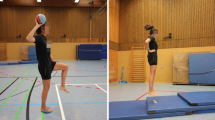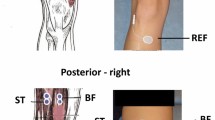Abstract
Purpose
Female athletes are at greater risk of non-contact ACL injury. Three-dimensional kinematic analyses have shown that at-risk female athletes have a greater knee valgus angle during drop jumping. The purpose of this study was to evaluate the relationship between knee valgus angle and non-contact ACL injury in young female athletes using coronal-plane two-dimensional (2D) kinematic analyses of single-leg landing.
Methods
Two hundred ninety-one female high school athletes newly enrolled in basketball and handball clubs were assessed. Dynamic knee valgus was analysed during single-leg drop jumps using 2D coronal images at hallux–ground contact and at maximal knee valgus. All subjects were followed up for 3 years for ACL injury. Twenty-eight (9.6%) of 291 athletes had ACL rupture, including 27 non-contact ACL injuries. The injured group of 27 knees with non-contact ACL injury was compared with a control group of 27 randomly selected uninjured knees. The relationship between initial 2D movement analysis results and subsequent ACL injury was investigated.
Results
Dynamic knee valgus was significantly greater in the injured group compared to the control group at hallux–ground contact (2.1 ± 2.4 vs. 0.4 ± 2.2 cm, P = 0.006) and at maximal knee valgus (8.3 ± 4.3 vs. 5.1 ± 4.1 cm, P = 0.007).
Conclusion
The results of this study confirm that dynamic knee valgus is a potential risk factor for non-contact ACL injury in female high school athletes. Fully understanding the risk factors that increase dynamic knee valgus will help in designing more appropriate training and interventional strategies to prevent injuries in at-risk athletes.
Level of evidence
Prognostic studies, Level II.


Similar content being viewed by others
References
Agel J, Olson DE, Dick R, Arendt EA, Marshall SW, Sikka RS (2007) Descriptive epidemiology of collegiate women’s basketball injuries: national collegiate athletic association injury surveillance system, 1988–1989 through 2003–2004. J Athl Train 42:202–210
Alentorn-Geli E, Myer GD, Silvers HJ, Samitier G, Romero D, Lazaro-Haro C, Cugat R (2009) Prevention of non-contact anterior cruciate ligament injuries in soccer players. Part 1: mechanisms of injury and underlying risk factors. Knee Surg Sports Traumatol Arthrosc 17:705–729
Alentorn-Geli E, Myer GD, Silvers HJ, Samitier G, Romero D, Lazaro-Haro C, Cugat R (2009) Prevention of non-contact anterior cruciate ligament injuries in soccer players. Part 2: a review of prevention programs aimed to modify risk factors and to reduce injury rates. Knee Surg Sports Traumatol Arthrosc 17:859–879
Arendt E, Dick R (1995) Knee injury patterns among men and women in collegiate basketball and soccer. NCAA data and review of literature. Am J Sports Med 23(6):694–701
Beckett ME, Massie DL, Bowers KD, Stoll DA (1992) Incidence of hyperpronation in the ACL injured knee: a clinical perspective. J Athl Train 27:58–62
Claiborne TL, Armstrong CW, Gandhi V, Pincivero DM (2006) Relationship between hip and knee strength and knee valgus during a single leg squat. J Appl Biomech 22:41–50
Dingenen B, Malfait B, Nijs S, Peers KH, Vereecken S, Verschueren SM, Staes FF (2015) Can two-dimensional video analysis during single-leg drop vertical jumps help identify non-contact knee injury risk? A one-year prospective study. Clin Biomech 30:781–787
Flynn RK, Pedersen CL, Birmingham TB, Kirkley A, Jackowski D, Fowler PJ (2005) The familial predisposition toward tearing the anterior cruciate ligament: a case control study. Am J Sports Med 33:23–28
Griffin LY, Agel J, Albohm MJ, Arendt EA, Dick RW, Garrett WE, Garrick JG, Hewett TE, Huston L, Ireland ML, Johnson RJ, Kibler WB, Lephart S, Lewis JL, Lindenfeld TN, Mandelbaum BR, Marchak P, Teitz CC, Wojtys EM (2000) Noncontact anterior cruciate ligament injuries: risk factors and prevention strategies. J Am Acad Orthop Surg 8(3):141–150
Hewett TE, Myer GD, Ford KR, Heidt RS Jr, Colosimo AJ, McLean SG, van den Bogert AJ, Paterno MV, Succop P (2005) Biomechanical measures of neuromuscular control and valgus loading of the knee predict anterior cruciate ligament injury risk in female athletes: a prospective study. Am J Sports Med 33:492–501
Jacobs CA, Uhl TL, Mattacola CG, Shapiro R, Rayens WS (2007) Hip abductor function and lower extremity landing kinematics: sex differences. J Athl Train 42:76–83
Kagaya Y, Kawasaki W, Fujii Y, Nishizono H (2010) Validation of a two-dimensional motion analysis technique for quantifying dynamic knee valgus during a drop landing by comparisons to data from three-dimensional analysis. Jpn J Phys Fit Sports 59:407–414
Kernozek TW, Torry MR, Van Hoof H, Cowley H, Tanner S (2005) Gender differences in frontal and sagittal plane biomechanics during drop landings. Med Sci Sports Exerc 37:1003–1012
Koga H, Nakamae A, Shima Y, Iwasa J, Myklebust G, Engebretsen L, Bahr R, Krosshaug T (2010) Mechanisms for noncontact anterior cruciate ligament injuries: knee joint kinematics in 10 injury situations from female team handball and basketball. Am J Sports Med 38:2218–2225
Leetun DT, Ireland ML, Willson JD, Ballantyne BT, Davis IM (2004) Core stability measures as risk factors for lower extremity injury in athletes. Med Sci Sports Exerc 36:926–934
McCarthy MM, Voos JE, Nguyen JT, Callahan L, Hannafin JA (2013) Injury profile in elite female basketball athletes at the Women’s National Basketball Association Combine. Am J Sports Med 41:645–651
McLean SG, Walker K, Ford KR, Myer GD, Hewett TE, van den Bogert AJ (2005) Evaluation of a two dimensional analysis method as a screening and evaluation tool for anterior cruciate ligament injury. Br J Sports Med 39:355–362
Noyes FR, Barber-Westin SD, Fleckenstein C, Walsh C, West J (2005) The drop-jump screening test: difference in lower limb control by gender and effect of neuromuscular training in female athletes. Am J Sports Med 33:197–207
Olsen OE, Myklebust G, Engebretsen L, Bahr R (2004) Injury mechanisms for anterior cruciate ligament injuries in team handball: a systematic video analysis. Am J Sports Med 32:1002–1012
Pappas E, Hagins M, Sheikhzadeh A, Nordin M, Rose D (2007) Biomechanical differences between unilateral and bilateral landings from a jump: gender differences. Clin J Sport Med 17:263–268
Ramesh R, Von Arx O, Azzopardi T, Schranz PJ (2005) The risk of anterior cruciate ligament rupture with generalised joint laxity. J Bone Joint Surg Br 87:800–803
Sallis RE, Jones K, Sunshine S, Smith G, Simon L (2001) Comparing sports injuries in men and women. Int J Sports Med 22(6):420–423
Shambaugh JP, Klein A, Herbert JH (1991) Structural measures as predictors of injury basketball players. Med Sci Sports Exerc 23:522–527
Smith HC, Vacek P, Johnson RJ, Slauterbeck JR, Hashemi J, Shultz S, Beynnon BD (2012) Risk factors for anterior cruciate ligament injury: a review of the literature-part 1: neuromuscular and anatomic risk. Sports Health 4:69–78
Smith HC, Vacek P, Johnson RJ, Slauterbeck JR, Hashemi J, Shultz S, Beynnon BD (2012) Risk factors for anterior cruciate ligament injury: a review of the literature-part 2: hormonal, genetic, cognitive function, previous injury, and extrinsic risk factors. Sports Health 4:155–161
Sueyoshi T, Emoto G, Yuasa T (2016) Generalized joint laxity and ligament injuries in high school-aged female volleyball players in Japan. Orthop J Sports Med 4:2325967116667690
Swanik CB, Covassin T, Stearne DJ, Schatz P (2007) The relationship between neurocognitive function and noncontact anterior cruciate ligament injuries. Am J Sports Med 35:943–948
Swart E, Redler L, Fabricant PD, Mandelbaum BR, Ahmad CS, Wang YC (2014) Prevention and screening programs for anterior cruciate ligament injuries in young athletes: a cost-effectiveness analysis. J Bone Joint Surg Am 96:705–711
Thijs Y, Van Tiggelen D, Willems T, De Clercq D, Witvrouw E (2007) Relationship between hip strength and frontal plane posture of the knee during a forward lunge. Br J Sports Med 41:723–727 discussion 7
Trojian TH, Collins S (2006) The anterior cruciate ligament tear rate varies by race in professional women’s basketball. Am J Sports Med 34:895–898
Van Mechelen W, Hlobil H, Kemper HC (1992) Incidence, severity, aetiology and prevention of sports injuries a review of concepts. Sports Med 14:82–99
Walden M, Hagglund M, Magnusson H, Ekstrand J (2011) Anterior cruciate ligament injury in elite football: a prospective three-cohort study. Knee Surg Sports Traumatol Arthrosc 19:11–19
Yeow CH, Lee PV, Goh JC (2010) Sagittal knee joint kinematics and energetics in response to different landing heights and techniques. Knee 17:127–131
Zazulak BT, Hewett TE, Reeves NP, Goldberg B, Cholewicki J (2007) Deficits in neuromuscular control of the trunk predict knee injury risk: a prospective biomechanical-epidemiologic study. Am J Sports Med 35:1123–1130
Acknowledgements
The authors thank Mr. Tsuyoshi Kimura and Kentaro Sasaki of Kinjyo University for their skilful technical assistance. Editorial support, in the form of medical writing based on the authors’ detailed directions, collating author comments, copyediting, fact checking, and referencing, was provided by Cactus Communications.
Author information
Authors and Affiliations
Contributions
JN conceived the study, participated in its design, and helped to draft the manuscript. KK, YS, and HT provided guidance about the study design. JN, TO, YT, and KS carried out the assessments and analysed the results.
Corresponding author
Ethics declarations
Conflict of interest
The authors declare that they have no conflict of interest.
Funding
This study received no funding.
Ethical approval
The study design was approved by the Ethical Committee of Graduate School of Medical Sciences, Kanazawa University (approval #1050).
Consent to publish
Participant provided written consent for publication of images.
Informed consent
Written informed consent was obtained from all the participants and their parental guardians. Additional informed consent was obtained from all individual participants for whom identifying information is included in this article.
Rights and permissions
About this article
Cite this article
Numata, H., Nakase, J., Kitaoka, K. et al. Two-dimensional motion analysis of dynamic knee valgus identifies female high school athletes at risk of non-contact anterior cruciate ligament injury. Knee Surg Sports Traumatol Arthrosc 26, 442–447 (2018). https://doi.org/10.1007/s00167-017-4681-9
Received:
Accepted:
Published:
Issue Date:
DOI: https://doi.org/10.1007/s00167-017-4681-9




